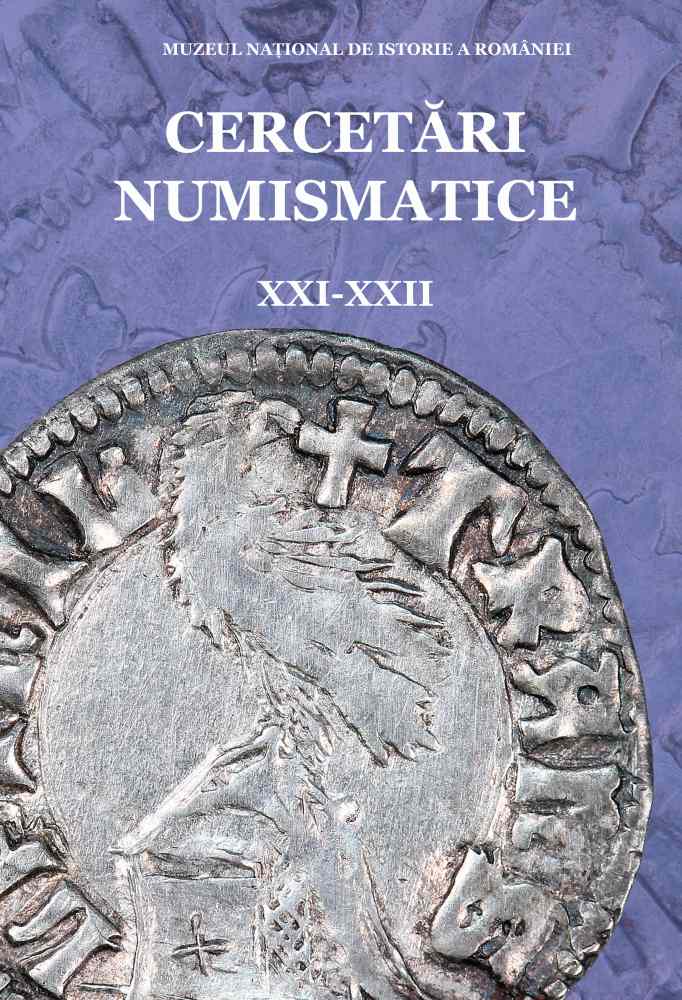
Tezaurul de la Viişoara, judeţul Teleorman (1942) / The Viişoara hoard, Teleorman County (1942)
| Autori |
|
| Secţiunea |
|
| Limba de redactare | română (rezumat în engleză) |
| Descriptori |
|
| Excerpt | The Viişoara hoard from Teleorman County was discovered in 1942 in the area of settlement, on the bank of the Călmăţui River, at Pârlita point, by two locals. The hoard, initially composed of 280 silver coins, was found in a clay pot, and it was divided between the two. During the first half of the following year, the police was able to retrieve 135 pieces of the hoard which subsequently entered the collection of the Coin Room of the Romanian Academy. The 135 coins that were retrieved from the hoard are categorized as follows: 122 tetradrachms struck in Macedonia Prima, that have the following mint marks: / - (2 coins); (1 coins); (2 coins); /N (3 pieces); / (1 piece); / - (1 piece); (7 pieces); / - (104 pieces), an imitation with the privy marks / and 13 pieces from Thasos (8 pieces with the letter M and 5 pieces with the privy mark ). From Viişoara is also mentioned an isolated discovery of a Macedonian tetradrachm before 1963, which was donated to Bucharest Municipality Museum. From the analysis of the monetary hoards that were hidden in different moments of the 1st century BC, we can deduce that Viişoara hoard was brought to the north of the Danube region in a period before king Burebista’s expeditions to the West, between 80-60 BC. This hypothesis is also supported by the Şieu-Odorhei hoard in Bistriţa-Năsăud County that also contained Macedonian tetradrachms with the later privy mark , slightly barbarized, with a clear degradation of the die. The latter was hidden during king Burebista’s expedition against the western Celts, between 60-55 BC. The composition of the metal used indicates the use of a high percentage of silver, between 96.2% and 99%; a fact that lead to their accumulation due to the quantity of precious metal that was used in order to create them. The same hypothesis can be applied in the case of the Thasos tetradrachms, which had a higher percentage of silver in their composition, between 97.7% and 99.7%. Thassian tetradrachms, that were part of the hordes from the North of the Danube that had in an overwhelming majority of M and privy marks, were issued at begging of the 1st century BC. They were well represented in the circulating coins in the southern regions of the Danube. The study of the mixt hoards, composed of Macedonian and Thassian tetradrachms, Dyrrhachium and Apollonia drachms, denarii from the Roman Republic, ornaments and jewelry, indicate that, due to the fact that they had a high percentage of precious metals, they were accumulated shortly after the raids of the Geto-Dacians alongside their allies from the south of the Danube. This demonstrates that this is not a case of monetary circulation but one of accumulating precious metal, which was considered prestigious assets that would assure a high status of its holder. The metal was sometimes used in the process of jewelry making that were considered objects that would bring fame and respect amongst the Geto-Dacians warriors. In analyzing the tetradrachms deposits from Macedonia Prima, there are not many indicators that can help us date the findings. The ones that are associated with Thasos tetradrachms indicate the same fact: a significant presence of Thassian type issues with M and coin mintage that establish the period of penetration of the hoards in the north of the Danube regions around the 1st century BC. The most important evidence is given by the republican denarii which, through the succesion of the deposits that were discovered in the region, assure a chronological grid of the moments when the silver coins arrived from the south of the Danube. However, the historiography speaks only of three mixt hoards that had in their composition Macedonian tetradrachms and republican denarii: Vărmaga in Hunedoara County (with one denarius from 81 a.Chr.), the one from Nicolae Bălcescu in Teleorman County (which was redated as from 42 a.Chr.) and Hunedoara hoard from Hunedoara County (which includes a late Macedonian tetradrachm with the privy mark , 42 republican denarii and one denarius from Vespasian). For the later ones, from the analysis of the denarii, we can assert that they were structured as follows: one group can be dated between 189-82 BC and three denarii issued between 49 and 38 BC. This information allows us to consider a gradual accumulation. The Macedonian coin could have reached the areal in the second half of the 1st century BC, one example could be the later pieces from Nicolae Bălcescu and Petrindu. The most important information is given by the mixt hordes composed of Thasos tetradrachms and republican denarii as they are more numerous. At a simple glance, they have the same route as the republican denarii deposits arrived from the South of the Danube during the 1st century BC. Therefore, they can be integrated in the groups of the hordes, which ends at the same moment. All the deposits that were hidden during the 1st century BC are directly linked to historical events that took place south of the Danube: the frequent barbarian attacks of roman Macedonia, the wars between Rome and Mithridates VI of Pontus, the ascension of the Getae king Burebista, and the actions of his successors. |
| Paginaţia | 11-72 |
| Descarcă fişierul | |
| Titlul volumului de apariție | |
| Editura | Publicat de: Muzeul Naţional de Istorie a României |
| Loc publicare | Bucureşti |


